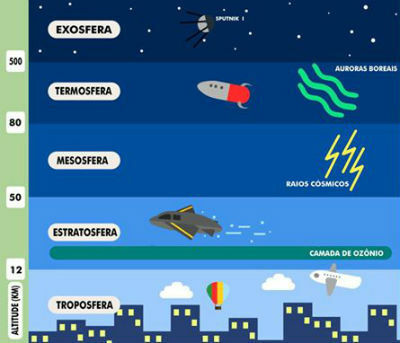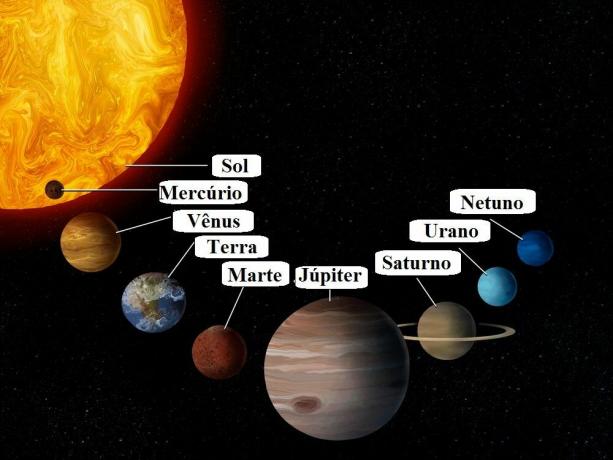The layers that make up the planet Earth's atmosphere are: Troposphere, Stratosphere, Mesosphere, Thermosphere and Exosphere.
Planet Earth's atmosphere surrounds the gases that are part of the planet and is usually vertically divided into concentric layers, defined by their temperature and pressure characteristics.
The density of the atmosphere decreases as it moves away from the Earth's surface. This happens because of gravity that draws gases and aerosols closer to the surface.
Note the location of each layer in the image below:

Troposphere
THE troposphere it is the lowest atmospheric layer, where living beings live and breathe. It extends from the earth's surface to a variable altitude between 8 km (at the poles) to 20 km (at Ecuador). Temperature decreases with altitude.
It is in the troposphere that weather-related phenomena occur and are greatly influenced by themselves, such as rain formation, most clouds, lightning and the extent to which pollution is concentrated donate.
In this layer are concentrated most of the gases: 21% oxygen, 78% nitrogen and 1% other gases.
The main features of the troposphere are:
- It is the densest layer of the atmosphere;
- The higher the layer's altitude, the lower the temperature, which decreases by about 6.5°C per km;
- The higher the altitude, the lower the concentration of gases, as the troposphere concentrates 75% of all air in the atmosphere.
THE tropopause it is the transition zone between the troposphere and the next atmospheric layer, the stratosphere.
Stratosphere
It is the second largest atmospheric layer on the planet and is where the ozone layer is located. At stratosphere, the constant temperature in the initial portion (extends to about 50 km above the ground), gradually increases to the top of the layer. This is due to the absorption of ultraviolet radiation by ozone.
It is in the stratosphere that planes, supersonic jets and weather balloons travel.
The main features of the stratosphere are:
- Made up of 19% of the gases in the atmosphere, ozone gas is in greater quantity than oxygen gas;
- The layer has almost no clouds and the air moves in the layer horizontally;
- Ozone molecules absorb the sun's ultraviolet light and transform it into heat.
THE stratopause it is the transition zone between the stratosphere and the next atmospheric layer, the mesosphere.
To learn more read Ozone layer.
mesosphere
The temperature decreases with altitude again in this range, reaching -90 ºC, which is why it is considered the coldest layer in the atmosphere. THE mesosphere reaches up to about 80 km.
Although it is a poorly studied region, it is known that most meteors are burned in the mesosphere due to the high density of gases that slow them down and cause the combustion process to take place.
The main features of the mesosphere are:
- Temperature decreases with increasing altitude;
- The gases present in the layer are denser;
- There is a greater incidence of ultraviolet rays from the Sun, as the gases become increasingly rarefied.
THE mesopause it is the transition zone between the mesosphere and the next atmospheric layer, the thermosphere.
thermosphere
This layer absorbs short waves of solar radiation that cause temperatures to be elevated. THE thermosphere it does not have a well-defined upper limit and is the most extensive layer of the atmosphere.
It is in this layer where the colored phenomenon called aurora occurs, the aurora borealis, in the Northern Hemisphere, and the aurora australis, in the Southern Hemisphere.
Inside the thermosphere, at altitudes above 80 km to about 300 km, there is a high concentration of ions, which is why the region is called Ionosphere. Ions originate from high-energy solar radiation.
When penetrating the ionosphere, they collide with atoms and molecules of oxygen and nitrogen, which are temporarily energized.
When these atoms and molecules return from their excited energetic state, they emit energy in the form of light, which constitutes the aurora borealis.
THE thermopause it is the transition zone between the thermosphere and the next atmospheric layer, the exosphere.
Read about what the Northern Lights.
exosphere
At exosphere, over 500 km, the movement of ions is conditioned by the magnetic fields of the Earth, this region being called magnetosphere. It is the last layer of the Earth's atmosphere and predates outer space.
Some particles follow the Earth's magnetic field towards the geomagnetic poles.
The main features of the exosphere are:
- This layer is basically formed by hydrogen and helium;
- Due to the presence of plasma, the temperature is around 1000 ºC;
- The air is very rarefied and, therefore, the passage of molecules into space occurs.
Composition of the layers of the atmosphere
The elements that make up air are essentially nitrogen and oxygen.
From approximately 80 km, this composition becomes more variable with suspended particles, water vapor and some gases in small quantities (argon, neon, carbon dioxide).
It also contains small particles called aerosols (ice crystals, dust, soot, chemicals, among others) mainly in the lower atmosphere, near the Earth's surface.
Also read:
- Atmosphere of planets
- What is Atmosphere?
- Earth Layers Exercises



